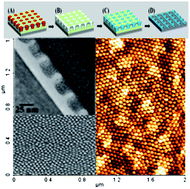A general method for controlled nanopatterning of oxide dots: a microphase separated block copolymer platform†
Abstract
We demonstrate a facile, generic method for the fabrication of highly dense long range hexagonally ordered various

* Corresponding authors
a
Materials Research Group, Department of Chemistry and Tyndall National Institute, University College Cork, Cork, Ireland
E-mail:
m.morris@ucc.ie
Fax: +353 21 474097
Tel: +353 21 461 948
b Intel Ireland Ltd., Collinstown Industrial Estate, Co. Kildare, Ireland
c Centre for Research on Adaptive Nanostructures and Nanodevices (CRANN), Trinity College Dublin, Dublin, Ireland
We demonstrate a facile, generic method for the fabrication of highly dense long range hexagonally ordered various

 Please wait while we load your content...
Something went wrong. Try again?
Please wait while we load your content...
Something went wrong. Try again?
T. Ghoshal, M. T. Shaw, C. T. Bolger, J. D. Holmes and M. A. Morris, J. Mater. Chem., 2012, 22, 12083 DOI: 10.1039/C2JM30468F
To request permission to reproduce material from this article, please go to the Copyright Clearance Center request page.
If you are an author contributing to an RSC publication, you do not need to request permission provided correct acknowledgement is given.
If you are the author of this article, you do not need to request permission to reproduce figures and diagrams provided correct acknowledgement is given. If you want to reproduce the whole article in a third-party publication (excluding your thesis/dissertation for which permission is not required) please go to the Copyright Clearance Center request page.
Read more about how to correctly acknowledge RSC content.
 Fetching data from CrossRef.
Fetching data from CrossRef.
This may take some time to load.
Loading related content
